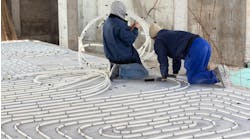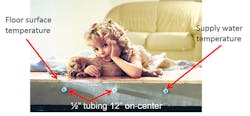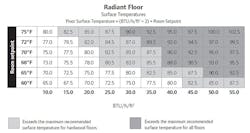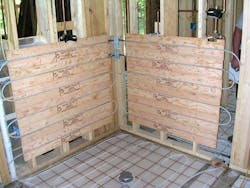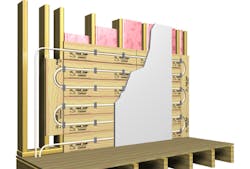Latest from Radiant
eBook: Nelson Mechanical Stories - Volume 1
Sponsored
A battery walks into a bar. The bartender yells, “Hey, don’t start anything here!”
Now, I don’t want to start anything here either. But I just have to say this: Sometimes, putting radiant tubing in the floor is not always the best installation for every radiant heating application.
I’m sure you’re thinking to yourself, “Wait a minute! I want warm toes! That’s why I installed radiant heating in the floor in the first place. Now you’re telling me that I’m not going to get my warm toes?!”
Let me explain.
Suppose I have a house, and I would like to add radiant heat to it.
· The basement is already finished, so I don’t have easy access to the floor joists to add tubing. So that option is out.
· I could install the tubing on top of the existing flooring in half-inch plywood panels called Quik Trak®, which have 5/16-inch grooved channels for the tubing. But if you have expensive hardwood floors or tile underneath, you certainly wouldn’t want to cover them up.
· Even on some new construction, there is so much stuff going into the floor joist these days that installing tubing under the floor just might not work anyway
And then, there is this other option.
Suppose we have a house that is 3,000-sq.ft. Heat loss calculations show that it needs 15 BTU/hr/ft2. Using today’s building codes with R-19 walls and R-43 ceilings and R-2.7 glass, we know 15 Btuh/square foot is a fairly normal number. (That figure means that at the coldest time of the year, this house will need 45,000 Btuh to heat the home to the desired setpoint of the thermostat, which in this example is 68°F).
To accomplish this, I am going to need the correct floor-surface temperature (see Figure 1). The formula for floor-surface temperature (Fst) is:
Fst = (BTU/hr/ft2 ÷ 2) + setpoint of the thermostat
Using the heat loss of 15 BTU/hr/ft2 and a setpoint of 68°F, the formula would look like this:
Fst = (15 ÷ 2 = 7.5) + 68°F = 75.5°F
Fst = 75.5°F
If you don’t like formulas, you can use the “Radiant Floor” chart in Figure 2 instead.
This means that, at the coldest temperature of the year, the floor-surface temperature would need to be 75.5°F to have an inside temperature of 68°F. And, at that floor-surface temperature, it will produce 15 BTU/hr/ft2. Toasty…but is it “toe toasty”?
So, here’s the issue. Floors at 75.5°F are not exactly the “toasty toe” temperature that customers want. The floor-surface temperature is just a few degrees above the setpoint of the thermostat. And, it is just a few degrees below the average surface temperature of your skin, which is about 83°F.
As houses get tighter and tighter, the required amount of BTU/hr/ft2 diminishes, which lowers the floor-surface temperature, which in turn means the floor-surface temperature gets closer and closer to the setting of the thermostat. The floors won’t be cold like forced air, but they aren’t going to be 80°F like some people are expecting.
So, is there an alternative? Yes. Put the radiant heating on the wall or the ceiling! There are several benefits to installing radiant heating in this type of application.
Benefit 1: Radiant walls and ceilings lend themselves to remodelling, since we don’t have to disturb anything on or under the floor. Also, if the homeowners later decide to put carpeting on the floor, it won’t affect the performance of the heating system like it would have if the tubing had been in the floor.
Adding carpeting to radiant floor heating systems can drive up supply-water temperatures as much as 60°F. In some cases, the supply-water temperature can get so high that condensing boilers cease to condense, which robs them of their efficiency.
As a side benefit, furniture placement has no effect on ceiling or wall radiant heating systems, either.
Benefit 2: Since we are not putting tubing under the flooring, we can increase the supply-water temperature another 20°F to increase our heat output without fear of warping any of the nice hardwood flooring. This means we can get the kind of performance we need with smaller amounts of radiant paneling needing to be installed.
Since we can use panel surface temperatures of up to 100°F (sometimes higher than that behind bead board on a radiant wall), it will greatly increase our thermal performance. Let’s see how much.
We’ll begin by renaming “floor-surface temperature” to “panel-surface temperature” and abbreviate it as: Pst.
We will use the following formula to calculate its expected output:
BTU/hr/ft2 = (Pst – setpoint) x 1.1
BTU/hr/ft2 = (100 – 68) x 1.1 = 35.2 BTU/hr/ft2
The resulting 35.2 BTU/hr/ft2 is more than double the output per square foot of radiant floor heating. And it gets even better when we install it on a wall, such as behind wainscoting.
Then the formula becomes:
BTU/hr/ft2 = (Pst – setpoint) x 1.4
BTU/hr/ft2 = (100 – 68) x 1.4 = 44.8 BTU/hr/ft2
Almost three times the performance of in-floor heat (45 vs. 15)! Imagine the comfort you could get if you installed radiant panels behind your shower walls. You know what it feels like to touch one of those cold walls when you are showering? Brrrrr! With radiant walls behind the cement board, you will be blanketed with luxurious warmth (see Figure 3).
Benefit 3: Since tubing in radiant walls and ceilings has a much lower mass than tubing installed in concrete, the former responds to temperature changes much quicker. This is important if the homeowners want to use setback thermostats.
These thermostats are generally not advised with high-mass systems, because it takes so long to recover after they return from setback. Plus, this low-mass application also helps prevent overheating, which can happen with some high-mass systems due to solar gain in the spring and fall.
Benefit 4: Radiant walls and ceilings heat furniture slightly above the air temperature. Remember that radiant heat does not give up its energy until it strikes an object. The sun is 93 million miles from the earth emitting radiant heat. It goes all the way through space without giving up its heat until it hits Earth. (It’s a good thing the sun radiates in all directions. If all of its energy were aimed at the earth, it would evaporate the planet in seconds!)
In the case of radiant ceilings and walls, the energy is pointed right at the objects in the room, so the floors will be heated slightly above the air temperature of the room. It may not be “toasty-toe” warm, but certainly more comfortable than the floor temperature of forced-air systems.
Installing a radiant wall
It is generally recommended that the radiant wall height be less than four feet to prevent homeowners from driving a nail for a picture into the tubing. Figure 4 shows a representation of how radiant tubing could be mounted on a wall. This is a great application for using radiant walls behind wainscoting with a chair rail.
The tubing comes up through the floor sill plate and is distributed back and forth through the channels in the plywood. If there is an electrical junction box in the wall, the tubing can be easily routed around the box using a router.
Installing a radiant ceiling
Radiant ceilings can be installed right over existing sheetrock, for example, as a remodel. There are many types of installation methods available, such as the plywood panels mentioned above; extruded aluminum panels that can be mounted to the ceiling; or foam panels that have grooves to accept the tubing. Check with manufacturers to find the one that best suits your needs. They will also provide installation instructions with their products to get a solid-performing radiant ceiling system.
Determining heat output
Let’s suppose we have a 10-ft. x 15-ft. room (150 ft2) with a heat loss of 15 BTU/hr/ft2. That would mean you would need a heat source of 15 BTU/hr/ft2 x 150 ft2, or 2,250 Btuh. Your heat source will have to provide 2,250 Btuh to heat this room at its outside design temperature. Since I can get 45 BTU/hr/ft2 out of a panel surface temperature of 100°F on a wall, the math would look like this:
2,250 ÷ 45 = 50 square feet of heated wall.
Since I don’t want to go higher than four feet, I further divide the 50 by 4, which equals 12.5 linear feet of heated wall that is 4-ft. high.
I would install the heated wall on the outside wall (since that is where most of my heat loss will be). If the 15-ft. wall happened to be the outside wall, I would do all 15-ft. in heated panels 4-ft. high, which will allow me to lower my supply-water temperature even more, giving me a little bit better savings on my fuel bill.
So, there you have it. Easier remodelling. Efficient and acceptable heat output. Lower mass for quick response. No worries about changes in floor covering — and still more comfortable floors than forced air.
You know, it’s not such an off-the-wall idea after all!
I would be grateful to hear your thoughts, ideas and stories. Until then, best regards and happy heating.
Steve Swanson is the national trainer at Uponor Academy. He actively welcomes reader comments and can be reached at [email protected].
Steve Swanson
Steve Swanson is the customer trainer at Uponor Academy. He actively welcomes reader comments and can be reached at [email protected].
